The story behind Jimmy Somma''s hand-built amp heads
As I take the train from New York City to Sommatone Amplification in Somerville, New Jersey, lush greenery and farms flash by the window and it’s easy to see why the area is called the Garden State. The Sommatone factory is actually part of a three-car garage nestled in the woods behind a ranch-style house abutting a large swimming pool. This is where Jimmy Somma designs and builds some fantastic-sounding heads and combos.
Somma brings a lot of playing experience to each amp design, too, and that’s because he spent years slogging it out in New Jersey’s highly competitive club circuit. His creations are not academic exercises based on oscilloscopes and ohm readings, nor are they flashy furniture pieces designed for the dens of wealthy hobbyists. They’re real-world workhorses created with a player’s ear for sound, and they’re built to a touring musician’s roadworthiness requirements. Somma eschews building Fender, Vox, or Marshall clones in favor of fashioning products that include some of the best features of each, with a range of models to suit just about any performing or recording need.
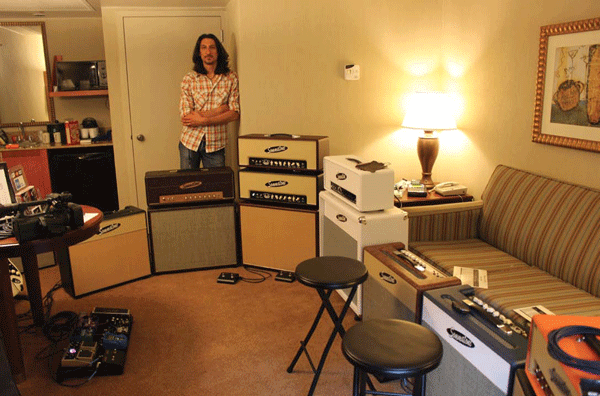
Jimmy Somma stands behind an alluringly daunting wall of amps at the New York Amp Show last June. Photo by Chris Kies
As his employees assemble amps, Somma explains how he got started and what differentiates his amps from those of other custom builders.
How did you get into guitar?
Ace Frehley—he was pretty much it. When I was six, I saw the cover to Alive! and discovered Kiss. My parents didn’t want to buy me the album, so my grandparents did. Hearing it, I knew I wanted to be a guitar player. My grandfather was a garbage contractor, and he would find broken guitars for me. My parents saw I was taking guitar seriously, so at seven I started taking guitar lessons. After a year, I didn’t think I was getting anything out of them, so I quit and started picking things up by listening to records. At 14, I took lessons again for about two years.
Did you fix any of those guitars your grandfather brought home?
Yes, though at first I had no idea what I was doing. But I’ve always been good at figuring out stuff on my own, so I started by restringing the guitars and by the time I was 12 or 13, I was replacing their pickups. I didn’t realize it was anything unusual—I just figured that’s what people did. My grandparents and dad were really handy and would teach me about tools and repairing things. With that little bit of knowledge, I just took off.
How did you start repairing amps?
I got into Eric Johnson, who is all about tone. That started me thinking: Why do classic guitar tracks sound the way they do? Why do certain amps sound better than others? I started reverse-engineering amplifiers to find out. I’ve owned Fender and Marshalls over the years, and I’d tweak them by experimenting with tubes and speakers. I began doing repairs for friends, and then for friends of friends, and then I started getting paid for it. For years, I repaired amps and guitars part-time, but eventually I quit my day job and went for it. That was eight years ago.
It’s one thing to solder pickups, but getting inside an amp can be dangerous.
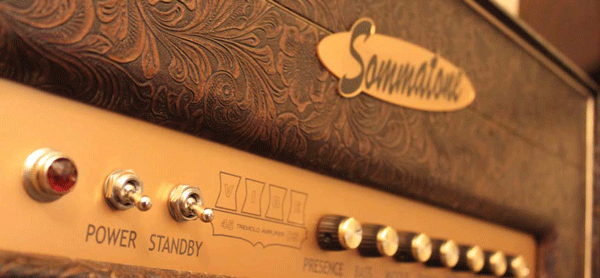 The front panel of Sommatone’s new Vibe-45 head, which features a badass tooled-leather covering and plexi-Marshall style interface. Photo by Chris Kies |
I took a very basic electronics course in high school, but I’m largely self-taught. I did a lot of research in old tube manuals and whatever I could find in the library about old electronics. I just focused on audio circuits. A lot of it comes down to being a player— it’s an important aspect of designing an amp properly. If you can’t make it sound good, how do you know it will sound good for anyone else? Even if you get feedback from other players, that’s only useful to a certain extent. Not to knock other builders, but listening to some of the sound clips on their websites, I feel like saying, “Please get someone who can play guitar to do your demos.” People ask me, “What is the most important thing in an amp?” Actually, tone is more of a recipe—a combination of the player, pickups, guitar, amp, and effects, and how they all interact.
How did you make the transition from repair to manufacturing?
Back around 2005, I was prototyping the original idea using some transformers and an old dual-EL84 Sano amp I gutted for the chassis. As I kept tweaking my design, it sounded better and better. I got some great feedback from players who tried the amp. I loved the way it responded. I had been gigging through a bunch of other amps and suddenly I had one that felt different than anything I’d used before. That became the Roaring 20—my first production amp. Then I got hooked up with my first artist endorser, Earl Slick [David Bowie, John Lennon].
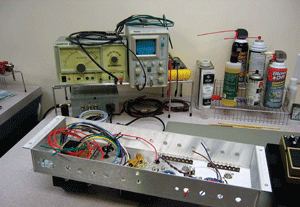 Somma’s ultra-clean workbench is outfitted with the requisite Lodestar audio generator, a Tenma oscilloscope, and a boatload of spray bottles. Photo by Michael Ross |
Our first dealer was Black Creek Guitars in New Paltz, New York, which is Earl Slick’s backyard. At the store, they told him, “You have to check out this new amp, we know you’ll love it.” He played through it and bought it on the spot. The owner called me up and said, “Earl Slick just left with your amp. I think you should talk to him.” Slick told me he loved it, but he might need a higher-output version for some gigs. That’s why we decided to build the 40-watt Roaring 40.
Does it have EL34 power tubes?
No, both models have EL84s. The Roaring 40 has four EL84s with a half-power switch, so you can run it at 20 watts. After designing the Roaring 40, I approached Slick about doing a signature model. That’s when I came up with the Slick 18. He wanted a small, low-wattage amp he could really crank up in his home studio without annoying the neighbors. A week after I brought it to him, I called and asked, “What do you think? Are there any changes you’d like?” He said, “Nothing. I think you are in my head.”
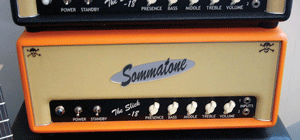 Sommatone’s first signature model, the EL84-powered Slick 18, came about after famed David Bowie sideman Earl Slick got hooked on another Sommatone at his local guitar shop. “A week after I brought it to him,” Somma says, “I called and asked, ‘What do you think? Are there any changes you’d like?’ He said, ‘Nothing. I think you are in my head.’” Photo by Michael Ross |
We have the Outlaw, our high-gain amp for hard rock and metal. It uses a pair of 6550s and pumps out about 70 watts. The Outlaw has lots of gain, but with the clarity I always felt was missing in high-gain amps. They sound mushy and overly compressed to me. We avoid that by having a type of high gain where you can hit a chord and all the notes are there. My employee Danny Arango was a big part of that amp, because he grew up playing metal.
Then there’s the 35-watt Overdrive 35, which is a 6L6-based, class-A design. You can get a lot of different sounds out of it, from tweed clean and tweed crunch to Dumble-style fusion—even close to Marshall sounds. I’m a huge fan of running things in class A. I think the response is completely different—it feels livelier. You’re not going to get as much power as with class AB, but when you roll the guitar volume back on a class-AB amp it still breaks up quite a bit. When you do that with a class-A amp, it becomes very clean, and it responds much better to your pick attack and guitar volume settings.
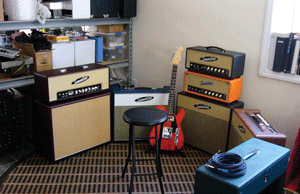 The Sommatone showroom is well stocked with a variety of combos and half-stacks in varying wattage and covering options. Photo by Michael Ross |
I can’t understand the mentality where a guy will drop crazy money on a goldtop or a ’59 Les Paul reissue and then play it through a Fender Hot Rod Deluxe. The amp is a bigger part of the equation. A ’59 Les Paul through a transistor amp is going to sound like a Les Paul through a transistor amp. But put an Epiphone through an amazing tube amp, and that guitar will sound really good.
What is the essential difference between your amps and the other custom amps out there?
The layout and the construction. A lot of manufacturers are doing a massaged kit. They’ll use a chassis from a kit supplier and basically make a Marshall or Fender. In the process of doing repairs, we’ll often open up “custom” amps and see another Fender or Vox clone with a different logo on it. We design our own chassis and a sheet metal company manufactures them for us. Most of our amps have true point-to-point wiring, as opposed to using a tag board. It is all about the purity of the signal path and having as little as possible in the circuit that is going to denigrate the tone and the sensitivity. When you have lengths of wire running close to one another you get interaction, even though there’s no contact. Your signal is not pure. So, where the components are located, how the wires are run, and keeping the links as short as possible are all important.
Does this affect the sound or the feel?
Both. A lot of times when you play through an old amp and push it hard, you’ll hear buzziness on top of the note—a shrillness. You can dial that out, but it shouldn’t be there to begin with. That’s parasitic oscillation. You don’t hear it as amp noise, but when you’re playing, it’s present as an impurity. A well-designed amp takes out those impurities and gives you this perfect sonic character. That’s the difference between a mass-produced amp with a PC board and someone who is paying attention to detail and designing the amp for perfection.
Do you have dealers where people can check out your amps?
Yes. You can find a list of dealers at sommatone.com. We’re actively expanding our dealer base because, ultimately, for people to hear the difference in our amps, they need to be able to play through them.
